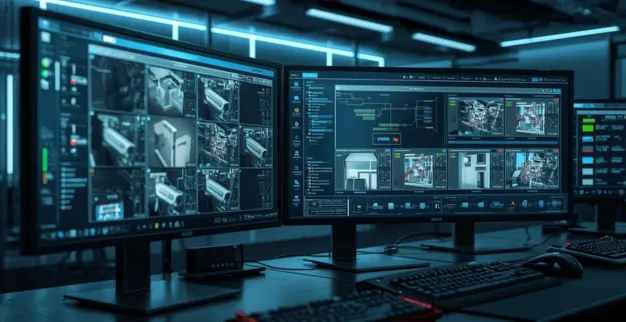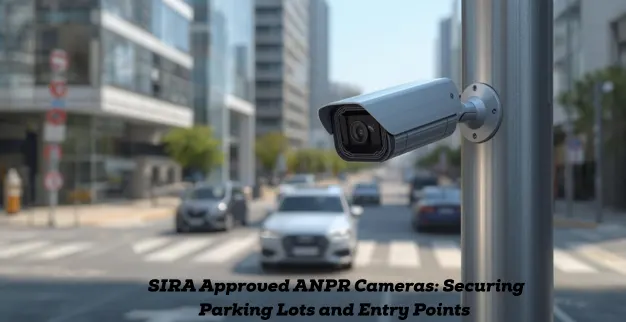SIRA Approved NVRs and VMS for Secure IT and Physical Monitoring
By: Ganesan D
29 Sep 2025
Category: CCTV security
In an era where threats aren’t just physical — they’re digital too — making sure your security infrastructure is both smart and compliant is no longer optional. SIRA approved NVRs & VMS offer businesses a powerful way to bring together IT security and physical monitoring under one robust system. Let’s explore how these systems work together to protect organizations and what you should look for in deploying them effectively.
What Are NVRs and VMS — And Why SIRA Approval Matters
NVR (Network Video Recorder) is a device or appliance that records video captured by IP cameras, stores it, and allows retrieval. It’s often more advanced than traditional DVR systems, handling higher resolutions, remote streaming, and networked storage.
VMS (Video Management System) is software (or software + hardware) that allows you to manage, view, record, analyze, and control many cameras and associated devices — often from multiple sites. It typically includes live monitoring, playback, alerting/analytics, integrations (with access control, alarms, etc.).
SIRA approval (Security Industry Regulatory Authority, Dubai) implies that your equipment & system design meet regulatory and technical standards required for surveillance, recording, monitoring, and data integrity. Using SIRA certified NVR + VMS helps ensure that your security system is trustworthy, legally compliant, resilient, and able to integrate with broader regulatory monitoring programs (like “Video Guard”).
Key SIRA Requirements for NVR & VMS
- VMS software must be installed in any Video Surveillance System (VSS) with 64 or more cameras or 4 or more recording devices.
- Control and management measures like passwords with different permission levels, dedicated control workstations, are required.
- Recording devices must be connected to UPS (Uninterruptible Power Supply), and the UPS must signal for safe shutdown when remaining battery drops to a threshold (e.g. 25%).
- The system must support integrity in recording quality: minimum resolution, proper frame rate, adequate storage retention (often not less than 31 days) and capacity with extra buffer.
- Integration capability with other physical security systems (alarms, access control, building management systems) may be required; in some cases approval from SIRA for certain integration (e.g. PSIM) is needed.
How NVR + VMS Combine to Provide Secure IT & Physical Monitoring
Unified Monitoring & Control — With a VMS that’s SIRA-approved, you can monitor multiple locations, devices, cameras, and integrate related systems (alarms, access control). NVRs feed data; VMS gives visualization, alerting, central dashboards. This makes it possible to detect physical intrusion, unauthorized access, or tampering, and correlate with IT security logs.
Data Integrity & Reliable Recording — Complying with SIRA standards means video must be recorded at high resolutions, proper frame rates, and stored securely (with redundancy via UPS, safe shutdowns) so that in case of power loss, tampering, or attempted deletion, the system retains accurate and usable records.
Scalability & Flexibility — Using VMS gives more flexibility: you can scale up (add more cameras, more sites) without being locked into specific NVR hardware. While NVRs are excellent for many scenarios, VMS platforms often offer more options (open platform, support for third-party devices, analytics). This helps businesses prepare for future expansion or evolving threats.
Cybersecurity Measures — Because VMS + NVR systems are networked, they’re subject to cyber risks: unauthorized access, firmware vulnerabilities, data interception. SIRA-approved systems are expected to enforce password policies, user-permission tiers, secure protocols. Also, updating firmware/software is critical. Integrations should avoid exposing surveillance systems to unnecessary external vulnerabilities.
Regulatory Compliance & Auditability — If something goes wrong — theft, data breach, physical damage — having a SIRA-approved system ensures the evidence is legally valid. The system's architect/design, the devices used (certified NVRs), the VMS logging, recording retention schedule all matter. This helps in audits, insurance claims, regulatory oversight.
Best Practices for Implementing Secure SIRA-Approved NVR + VMS Systems
| Practice | Why It’s Important |
|---|
| Choose hardware/software that is explicitly SIRA certified | Ensures compliance, fewer regulatory obstacles. Eg: Milestone Systems’ XProtect and Husky X8 NVR are SIRA-approved. Wavestore VMS also achieved SIRA approval. |
| Maintain strong passwords, access controls, user permissions | Limits insider threats; prevents unauthorized access. Required by SIRA. |
| Ensure UPS backup & safe shutdowns | Power failures shouldn’t lead to data loss or corruption. Required thresholds (e.g. 25%) matter. |
| Adequate storage & retention | Must meet requirements (e.g. 30+ days playback, buffer capacity). Avoid losing critical evidence. |
| Regular firmware/software updates & patches | To protect from known vulnerabilities. VMS/NVR platforms & camera firmware must be kept current. |
| Use segmentation and network security | Place surveillance network on separate VLAN or subnet; limit remote access; encrypt traffic. |
| Integrate with other systems smartly | Access control, alarms, BMS integration increases awareness. Ensure secure APIs and that SIRA approval covers the integrations. |
| Monitor system health & alerts | Through VMS dashboards, logins, device status; ensure alerts for camera failure, disk issues, etc. SIRA’s “Video Guard” program does this for faults. |
Challenges & How to Mitigate Them
Legacy equipment & proprietary systems: Older NVRs or VMS that aren’t open-platform or lack security updates may not meet SIRA requirements. Upgrading or replacing parts may be necessary.
Cost and complexity: Compliance, hardware, licenses, redundancies add cost. But it’s a long-term investment in protection & legal safety.
Operational capacity: Managing many cameras/sites, ensuring uptime, monitoring alerts, maintaining storage — all require trained staff or outsourced services.
Cyber threats evolving: As with any connected device, surveillance systems are targets. Stay updated with best practices, threat intelligence, patches, and secure configs.
Real World Example: Milestone & Wavestore in Dubai
Milestone Systems’ Video Guard: Its VMS (XProtect Corporate, Expert, Professional+) and Husky X8 NVR are both SIRA approved. Its Video Guard service monitors system faults and delivers alerts to clients/service providers for immediate corrective action.
Wavestore VMS also obtained SIRA approval. It supports integration with the Video Guard program / SIRA web services to monitor operational status of installed security equipment across Dubai.
These examples show how choosing approved solutions can bring visibility, accountability, and adherence to regulatory expectations — protecting both assets and legal standing.
Getting Started: A Roadmap for Your Business
- Audit your current surveillance setup — list NVRs, VMS, cameras, retention, firmware versions, network configuration.
- Map requirements — number of cameras, resolution, retention, sites, and desired integrations (access control, alarms, analytics).
- Select SIRA-approved hardware/software — ensure models are certified; vendors provide documentation.
- Design for network & security — isolate video traffic, enforce encryption, access control, secure remote access; ensure UPS backup.
- Implement logging, monitoring & alerting — system health checks, notifications of failures.
- Train staff — physical maintenance and digital hygiene.
- Plan for maintenance & upgrades — adapt to evolving technology and regulations.
Conclusion
Securely monitoring both the physical world and your IT environment is no longer about choosing between CCTV or cyber defenses — it’s about integrating them. SIRA approved NVRs and VMS bridge the gap, giving you systems that are high-quality, compliant, robust, and resilient.



